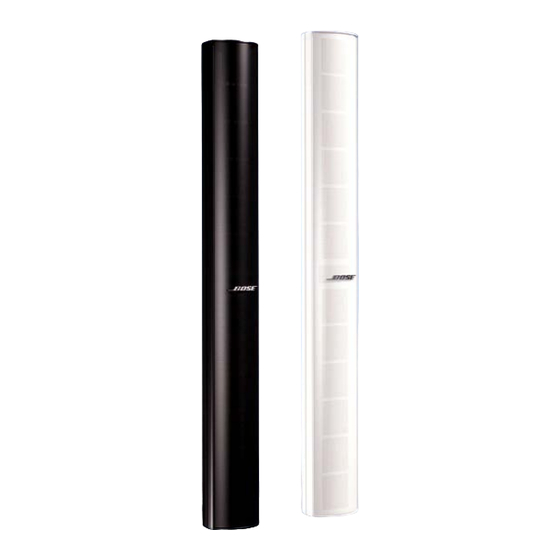Bose Panaray MA12 Technische Grundlagen & Diskussion - Seite 8
Blättern Sie online oder laden Sie pdf Technische Grundlagen & Diskussion für Redner Bose Panaray MA12 herunter. Bose Panaray MA12 36 Seiten. Modular line array loudspeaker
Auch für Bose Panaray MA12: Benutzerhandbuch (2 seiten), Installationshandbuch (16 seiten), Installationshandbuch (8 seiten), Installationshandbuch (7 seiten), Service-Handbuch (11 seiten)

Of course, as with any engineering solution, the hang-and-tilt approach is not perfect. It has
its strengths and weaknesses as they relate to the goal of cost effectively satisfying the major
customer requirements. The details of these strengths and weaknesses are the subject of the
next section.
Strengths of the hang-and-tilt approach
T
strengths of a good hang-and-tilt system are that with it, excellent tonal balance,
HE
consistent sound level, and speech intelligibility can be achieved. Moreover, because the
speakers are located up and out of the way, they rarely interfere with sightlines.
Over the years, Bose and others have developed a number of technological solutions
specifically designed to improve the quality of hang-and-tilt systems. For example, Panaray
LT speakers are designed with very narrow sound radiation patterns so that designers can
carefully aim them only onto audience areas and avoid reflective walls and ceilings that can
produce the excessive reverberation responsible for diminished speech intelligibility. These
speakers also exhibit a very sharp rolloff of sound outside their primary radiation angles,
making it easier to combine two or more in such a way that they exhibit a minimum of the
inter-speaker interference that can lead to dropouts in sound.
Similarly, the Bose Panaray 502
field of hang-and-tilt speakers because it delivers consistent coverage over substantially a full
range of frequencies using very natural sounding cone-type drivers in a very small package.
This speaker is used in literally thousands of venues around the world where customers say it
meets their needs elegantly and unobtrusively.
As a final example of the types of innovations that have led to better hang-and-tilt systems,
until very recently it was thought to be difficult or impossible to include control of the lower
frequencies in hang-and-tilt designs. This lack of control meant that bass sound waves were
more or less allowed to go anywhere within a venue, causing a lack of clarity in music and
some masking of speech (and therefore a reduction of speech intelligibility). Today solutions
exist to control bass frequencies in hang-and-tilt designs with very nearly the same degree of
precision as the higher frequencies, including a comprehensive technique developed by Bose.
These solutions, which employ advanced array theory, have led to noticeable improvements
in the sound quality of systems in which they have been used.
Weaknesses of the hang-and-tilt approach
T
hang-and-tilt approach also has some weaknesses. For example, the designer must
HE
ensure that the sound radiation pattern from the speaker being considered is appropriate for
the purpose of covering the audience area. However, the choice of speakers is limited to only
a few, which differ according to their radiation patterns. It is purely coincidence and therefore
rare for the designer to find a perfect match between the available radiation patterns and the
audience area. In general, the speaker being considered will have more or less coverage than
what is needed.
®
Bose
MA12™ Modular Array: Technical Foundation & Discussion
April 2002, © Bose Corporation, All Rights Reserved
®
A loudspeaker represents an important contribution to the
Page 8 of 36
®
